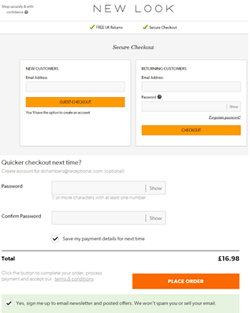
Attribution modelling is a set of rules that determines which touchpoints during a customer’s journey have resulted in the highest amount of conversions, allowing you to pinpoint the marketing channels that are driving the most revenue. Without attribution modelling, knowing whether your marketing campaigns need to be optimised becomes almost impossible.
While attribution modelling has seen progress over the years, it still remains as one of the toughest challenges faced by marketers today. With this in mind, here are five common attributions all sites suffer from and how to fix them.
Not Tracking Touch Points
Before understanding attribution, it’s important to understand what touch points are. A touch point relates to any contact a prospective customer makes with your brand before, during or after a purchase. Identifying your business’ touch points is the initial step towards producing a customer journey map that’ll ensure your customers are satisfied every step of the way. If you aren’t tracking touch points, how can you know which marketing campaigns are driving enquiries and producing the most sales?
Call tracking software, such as that of Mediahawk, stores the contact data for each session and every individual customer, enabling you to conclude if a lead has visited via organic search, a referral or a remarketing pay-per-click (PPC) ad and has finally called your business through their unique telephone number, which is generated through the call tracking software. All the produced data is stored specifically for that user, providing a complete view of their journey.
Relying Solely on First & Last Click Models
Although we have said you should track from the initial touch point enquiry through the full conversion, what about all of the ones that happen in-between?
When businesses decide to start considering marketing attribution, it’s easy to assume that first and last-touch attribution is the best solution. First-touch attribution gives 100% of the credit for a conversion to a consumer’s first touch point; whereas last-touch attribution applies credit to the very last touch point leading up to a conversion. However, using this attribution model means you are only focusing on the top of the sales funnel (first click) or the bottom of the sales funnel (last-touch).
Applying credit to a single touch point will result in an attribution model bias. Remember, the sales cycle typically involves multiple touchpoints that influences a consumer’s journey, so how can you possibly give one touch point all the credit?
Ensuring that you are attributing your touch points throughout the entirety of your customer’s sales funnel will help determine which marketing channels are thriving and which are underperforming. You can then use this data to reallocate budget into optimising campaigns to generate more conversions and sales.
No Cross-Device Tracking
Nowadays, consumers are using multitude of screens (desktop, TV, tablets, smartphones) throughout their journey. This is undoubtedly one of the hardest gaps to close due to the complexity required to track individual users across multiple screens.

Cross-device attribution identifies the touch points and events that have contributed most to a conversion throughout a customer’s journey spread across several devices. However, as users switch from device to device, it becomes difficult to maintain the unique IDs used to track their journey.
Other types of attribution, such as cross-channel attribution rely heavily on cookies stored in the customer’s device to identify and track them, enabling marketers to see an individual customer’s touch points in their journey. Cookies are not interchangeable between devices, e.g. the cookies on your laptop cannot be transferred to your smartphone or tablet. Is it actually possible to engage with users across different devices?
One of the most common ways to locate a specific user across multiple devices is through an email address, for they are frequently used not only for sending and receiving emails, but also for logging into different websites and apps and creating accounts. For example, a user could login to the Gmail account on their smartphone, desktop or tablet – this allows Google to locate this user across three different devices because they use the same email address to access Google Apps.
Convincing customers to create accounts during their purchase is a quick way to obtain their email address and encourage them to access your website across different devices. However, it’s best to place these requests at the end of the checkout process, as forcing customers into creating accounts with no possibility of a guest checkout can increase shopping cart abandonment rates.

New Look allow their customers to complete their purchase before requesting them to create an account afterwards. By removing the element of force within the checkout process, customers are more likely to create an account at their own accord. As New Look also have a smartphone/tablet app, they’ll be able to track whether a user starts on one device and moves to another during their purchase, meaning the exact device that triggered the conversion can be identified.
One Cost for All Leads
When allocating marketing budget, relying on a single cost per lead (CPL) is common strategy. However, not all leads are created equally, for some convert and much higher rates than others; meaning it’s more practical to invest more into high-quality leads in comparison to those who don’t covert as often (low-quality leads). If you have a single cost allocated for all leads, then you could be wasting a considerable amount of your budget.
The best approach for your cost per lead is to vary is by channel. Attribution data can produce a lead report and a revenue report that is segmented by marketing channel. This will help analyse which leads convert at a high rate and which bring in the most revenue, meaning you can generate the highest return on investment (ROI) from your leads.
Failing to Attribute Online and Offline
Despite progress being made, the majority of the attribution models that most marketers are using today only offer a partial solution that only tracks digital conversions and sales, not including the impact online has to offline sales, leads and in-store visits. Currently, Google is looking to solve this attribution problem through their “In-Store Visits” metric, which will use Google maps data, WIFI, GPS and visitor enquiries to gauge online to offline impact.
It is estimated 82% of smartphone users consult their phone over an in-store purchase, so being able to follow an individual customer’s journey across online and offline is crucial for attributing interactions for each customer at a personal level, instead of channel level is crucial.
Introducing unique promotional codes for each channel is one of the easiest ways to link online to offline attribution – this is a great way to gather direct responses from a marketing campaign. They also provide a mutual benefit for both marketers and customers – the marketers can measure how many responses the campaign receives; whilst the customer can purchase more for the lowest price. It also provides consumers with a choice over where they can convert – online or in-store.
By tracking a promotional code’s redemption, marketers can quickly identify how many online to offline sales were made via a specific marketing channel, meaning their success can be measured.
About the Author
Natalia Selby is Marketing coordinator at Mediahawk, with over 10 years experience in analytics, content management and eCommerce.




